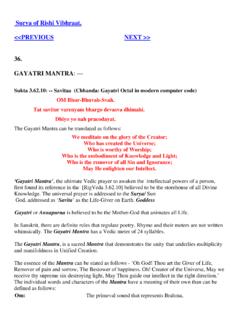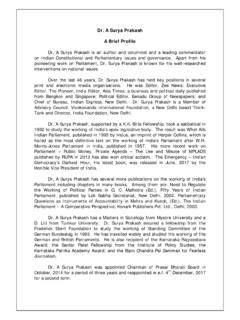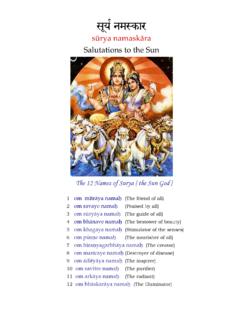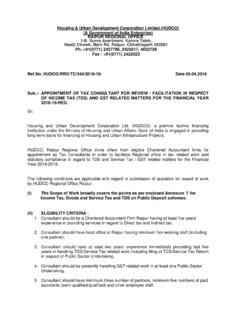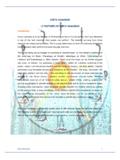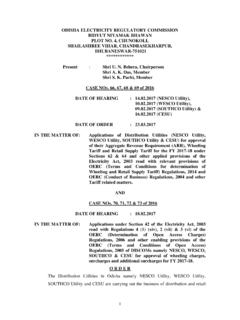Transcription of COSMIC/CORONAL ORNAMENTS AND WEAPONS …
1 ONENESS OF PARABRAHM AND SHIVA LING. COSMIC/CORONAL ORNAMENTS AND WEAPONS OF WAR. << PREVIOUS NEXT >>40 MAHA MRITUNJAYA MANTRA: ---- ( ) -- Rishi Vashishthah, Devata Marutah: Rudra, Chhanda Gayatri. ]OM. Tryambakam yajamahe Sugandhim pushti-vardhanam Urvarukamiva bandhanan Mrityor mukshiya mamritat OM. We worship and adore you, O three-eyed one, O Shiva. You are sweet gladness, the fragrance of life. You nourish us, restore our health, and causes us to thrive. As, in due time, the stem of the cucumber weakens, and the gourd if freed from the vine, so free us from attachment and death, and do not withhold immortality.
2 Elaboration of the Mantra:--- The Maha Mrityunjaya Mantra or Lord Shiva Mantra is considered extremely powerful and significant by the Hindus. Also known as the Moksha Mantra of Lord Shiva, chanting of Maha Mrityunjaya Mantra is said to create divine vibrations that heals. Devotees of Lord Shiva further believe that Maha Mrityunjaya evokes the Shiva within human beings and removes the fear of death, liberating one from the cycle of death and rebirth. There are many Mantra/hymn for warding off evils like death and other suffering given in the sacred literature of the Hindu s. The Mrityunjaya Mantra has been extolled in sacred literature as being the best.
3 This Mantra is addressed to Lord Shiva and is taught in the Rig Veda [ ] as well as the Yajur Veda [3-60] showing that it is a Sruti received by Maharishi Vasistha, the Kula Guru of Bhagavan Sri Ramachandra. Anybody can recite this mantra and attain good health, release from bondage and other problems. These body parts are the crucial centers for the spiritual energy. Head: - Rishi (Guru/teacher of the Mantra) is Maharishi Vasistha. Devataa (the deity of the Mantra) - hridaya (heart):- In this case the Devataa is Lord Shiva addressed as Sri Mrityunjaya Tryambakeswara Devataa . Mouth: - Channda (meter, which is technically very specific for each Mantra).
4 Padas/feet: - This vedic mantra is in Anusthup Channda and accordingly this is a meter having four pada (feet) of 8 phonemes each making the entire Anusthup meter as composed of 32 (8 x 4 = 32) syllables. It maybe noted that any change in the meter shall cause a distortion in the Channda and the mantra vibration shall be ruined. The first pada is Trayambakam Yajamahe and means We worship or sing the praise of Lord Trayambaka. Trayambaka is the name of Lord Shiva as the father of the three worlds - Bhu, Bhuva and Svarga Lokas. He is the father and lord of the three mandalaas - Surya, Soma and Agni mandala. He is Maheswara, the lord of the three Guna s - Satva, Rajas and Tamas.
5 He is the Sadashiva, the teacher of the three Tatvaas - Atma Tatva, Vidya Tatva and Shiva Tatva. He is the father (cause and source) of the three energies/Agni - Aavaahaniya, Garhapatya and Dakshinagni. He is the father of all physical creation through the three Murti Bhuta - Prithivi (solid), Jala /liquid and Tejas/radiance or Agni /Thermal energy. He is the lord of the three heavens created by the dominance of the three Gunas - Rajas (Brahma), Satva (Vishnu) and Tamas (Shiva). Know Him to be the nirakara (formless) Sadashiva as He is above this physical mode and is their Maheswara. This is the first foot of the Mantra (composed of eight syllables). Bija (the seed syllable that created the Mantra and contains the Mantra within itself, like the seed that creates the tree) - Ling - the Jyotirlinga.
6 ONENESS OF PARABRAHM AND SHIVA LING. TRAYAMBAKKAM refers to the three eyes of Lord Shiva. Trya means Three and Ambakam means eyes. These three eyes or sources of enlightenment are the Trimurti or three primary deities, namely Brahma, Vishnu and Shiva and the three AMBA (also meaning Mother or Shakti are Saraswati, Lakshmi and Gouri. Thus in this word, we are referring to God as Omniscient (Brahmaa), Omnipresent (Vishnu) and Omnipotent (Shiva). This is the wisdom of Brihaspati and is referred to as Sri Duttatreya having three heads of Brahmaa, Vishnu and Shiva. Shakti (the physical power of the Mantra like the mother) - Pada (feet): It is the giver of gati or direction.)
7 In this case the Shakti is Devi Amriteswari. YAJAMAHE means, We sing Thy praise . The second pada of the mantra is Sugandhima Pushtivardhanam. Sugandhima refers to the fragrance of the flower that spreads in all directions, and in a similar way Shiva is present in the entire creation, both animate and inanimate. In all the bhutas (modes of existence), in the three Gunas (nature of creation as being Satva, Rajas or Tamas), in the ten Indriyas (five Gyana-indriyas or senses and five Karma-indriyas or organs of action), in all the Devataas (33 Devataass are the source of all illumination and enlightenment) and the Ganas (hosts of demi-gods), Shiva exists and pervades as the illumine Aatma (soul) and is their essence.
8 Pustivardhanam is now being explained. That inward dwelling spirit (Aatman), the Purusha Shiva is the real sustainer of Prakrati/Nature (and not vice-versa as all people perceive). Starting with the Mahatatva (primordial state of matter/energy) to the individual parts of Creation, the entire sustenance of the physically created beings (both animate and inanimate) is done by the imperishable Purusha. You, I, Brahmaa, Vishnu, the Munis/sages and even Indra and Devataas are maintained/sustained (by the Aatma and at is Him). Since the Purusha (Atma - Shiva) is the granter of sustenance to Prakrati (body/nature), he is Pusti-vardhana . The next two Padas (consisting of sixteen syllables) is Urvaarukamiva bandhanan mrtyor muksiya maamrtaat meaning Prabhu!
9 Just as the ripe cucumber is severed from the bondage of the creeper, in the same manner may we be delivered from death for the sake of immortality (Moksha). Rudra Deva is like Amrita (nectar of immortality). Those who worship Him with good Karma, penance and repentance, meditation, contemplation, prayer or praise, will surely renewed life and vigor. The strength of truth force (in this Mantra) is such that Lord Shiva shall definitely free the worshipper from the bondage of death because Shiva alone is the giver of bondage and Moksha. This is the Mritasanjivani Mantra and has the power to give back life and rescue from death and great evils. You should adore Lord Shiva and recite this mantra.
10 Water sanctified with this Mantra should be drunk all the time. Understanding the Maha Mrityunjaya Mantra is made clear as below:--- It is important to understand the meaning of the words as this makes the repetition meaningful and brings forth the results. OM is not spelt out in the Rig-Veda, but has to be added to the beginning of all Mantras as given in an earlier Mantra of the Rig-Veda addressed to Ganapati. SUGANDHIM refers to His fragrance (of knowledge, presence and strength three aspects) as being the best and always spreading around. Fragrance refers to the joy that we get on knowing, seeing or feeling His virtuous deeds. PUSTIVARDHANAM: Pushan refers to Him as the sustainer of this world and in this manner.
